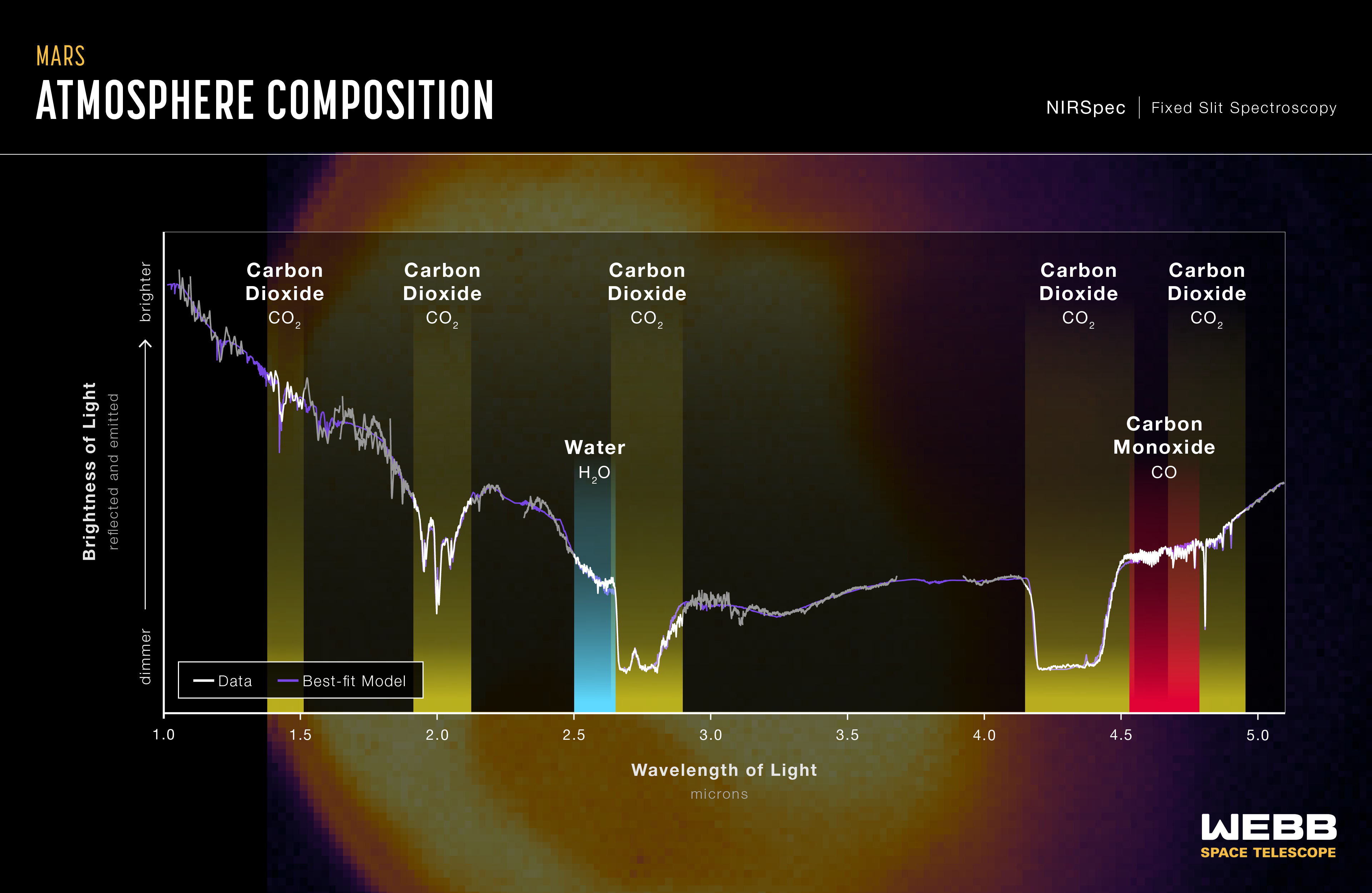1 min read
Mars (Near-Infrared Spectrum)

Editor’s Note: The findings reported here are based on preliminary results that have not been shared formally with the scientific community via peer-reviewed publication.
Webb’s first near-infrared spectrum of Mars, captured by the Near-Infrared Spectrograph (NIRSpec) on September 5, 2022, reveals chemical and physical properties of Mars’ surface and atmosphere. Data are shown in white, with a best-fit model in purple.
The spectrum shows a combination of sunlight reflected from Mars’ surface and atmosphere, and light emitted by the planet as it gives off heat. Wavelengths between 1 and 3 microns are dominated by reflected light, while those between 3 and 5 microns are dominated by emitted light. Both the reflected and emitted light pass through Mars’ atmosphere, affecting the brightness of various wavelengths and the shape of the spectrum in various ways.
The deep valleys are absorption features caused when specific wavelengths are blocked by gases such as carbon dioxide, water, and carbon monoxide. Other details, like the broad shape of the spectrum and the slope of the curve at different points, reveal information about dust, clouds, and surface features.
The data were collected using six different high-resolution spectroscopy modes (grating modes), each of which covers a different wavelength range. (The white line is not continuous because there are small gaps in coverage.) The best-fit model takes into account the data as well as other known properties of Mars. Constructing a best-fit model using a tool such as the Planetary Spectrum Generator makes it possible to estimate abundances of given molecules in the atmosphere.
NIRSpec was built for the European Space Agency (ESA) by a consortium of European companies led by Airbus Defence and Space (ADS) with NASA’s Goddard Space Flight Centre providing its detector and micro-shutter subsystems.
See the Fast Facts below for additional technical details.
About the Object
- DistanceDistanceThe physical distance from Earth to the astronomical object. Distances within our solar system are usually measured in Astronomical Units (AU). Distances between stars are usually measured in light-years. Interstellar distances can also be measured in parsecs.On September 5, 2022, Mars was 0.92 astronomical unit (86 million miles or 140 million km) away from Earth.
About the Data
- Data DescriptionData DescriptionProposal: A description of the observations, their scientific justification, and the links to the data available in the science archive.
Science Team: The astronomers who planned the observations and analyzed the data. "PI" refers to the Principal Investigator.The spectra were taken on September 5th 2022 (23:30 UT) with the narrow NIRSpec slit and the fast readout with the SUBS200A2 mode. The shown spectra are a combination of data collected over 3 gratings (G140H, G235H, G395H) with 2 orders per grating (NRS1, NRS2). The planet was mapped with several slit positions. In this particular composite, only non-saturated spectra are shown; they sample different locations along the planet. At this preliminary stage, the data are not flux calibrated and for display purposes, the continuum fluxes have been scaled to a model spectrum (purple line) as computed with the Planetary Spectrum Generator (PSG, https://psg.gsfc.nasa.gov).
These observations are part of the JWST Mars GTO (Guaranteed Time Observations) program 1415 (G. Villanueva).
- InstrumentInstrumentThe science instrument used to produce the data.NIRSpec
- Exposure DatesExposure DatesThe date(s) that the telescope made its observations and the total exposure time.September 5th 2022 (23:30 UT)
- FiltersFiltersThe camera filters that were used in the science observations.The shown spectra are a combination of data collected over 3 gratings (G140H, G235H, G395H) with 2 orders per grating (NRS1, NRS2).
- Object NameObject NameA name or catalog number that astronomers use to identify an astronomical object.Mars
- Object DescriptionObject DescriptionThe type of astronomical object.Terrestrial (rocky) planet
- Release DateSeptember 19, 2022
- CreditImage: NASA, ESA, CSA, STScI, Mars JWST/GTO Team
Share
Details
Laura Betz
NASA’s Goddard Space Flight Center
Greenbelt, Maryland
laura.e.betz@nasa.gov
NASA, ESA, CSA, STScI, Mars JWST/GTO Team






























